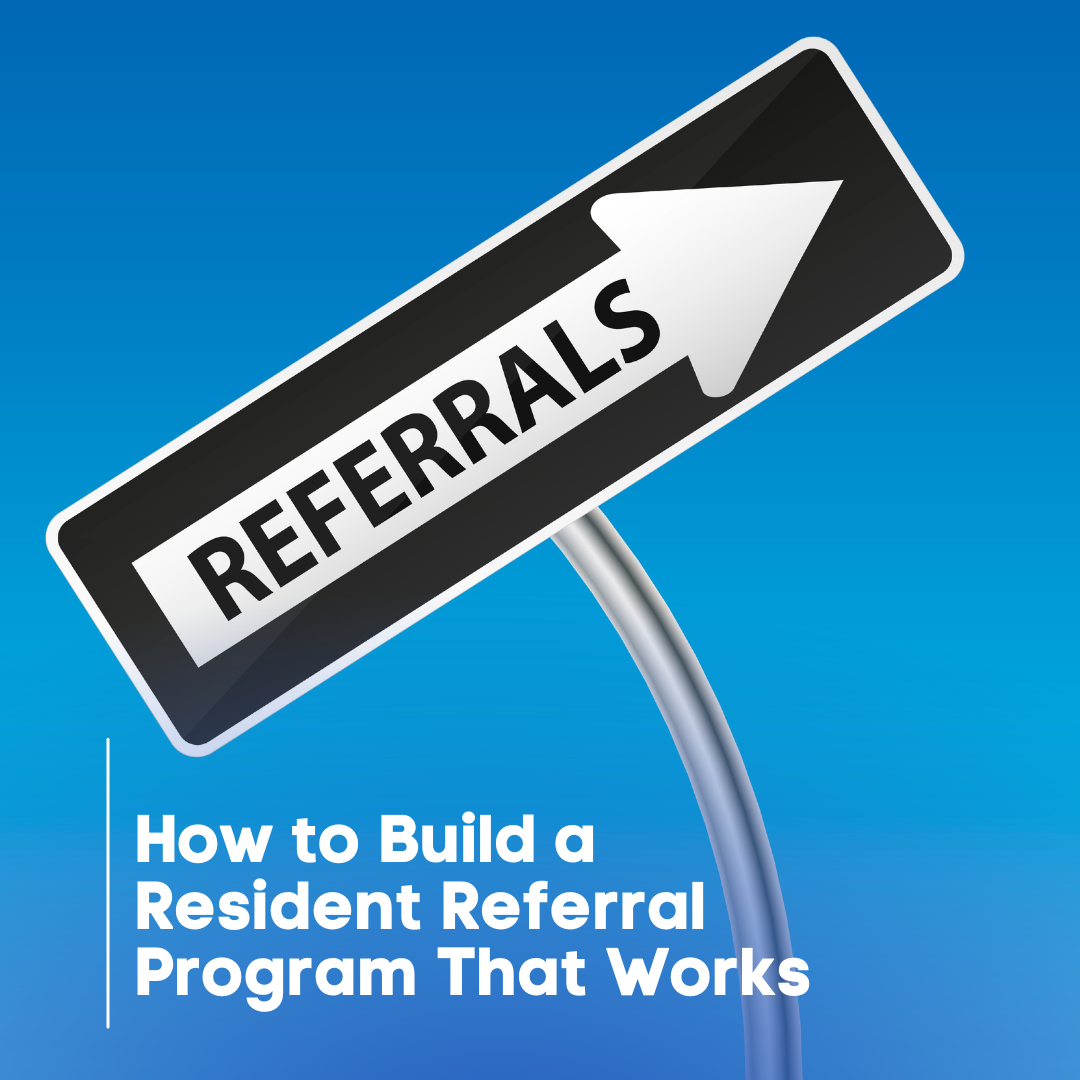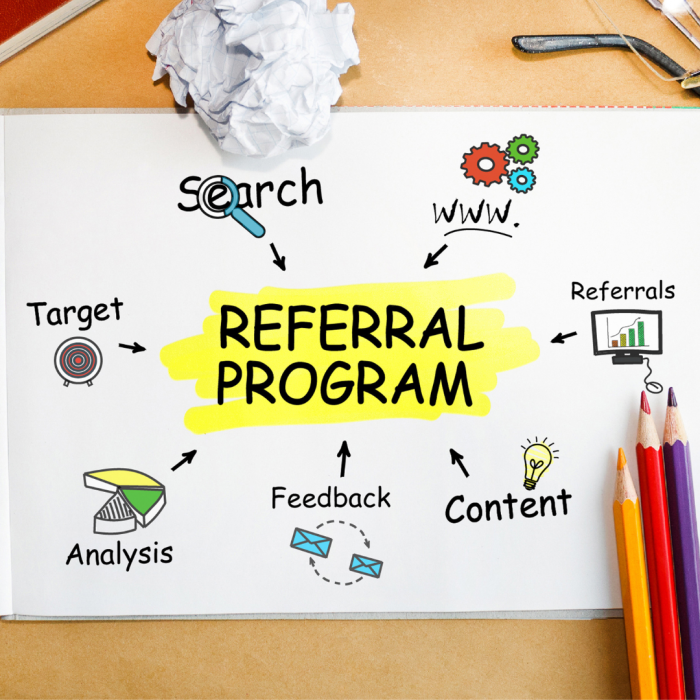
Word of mouth is one of the most powerful yet often underutilized marketing tools in property management. When residents genuinely love where they live, they naturally share their enthusiasm. However, without a clear plan in place, a valuable resident referral can slip through the cracks, missing the opportunity to convert happy residents into a steady, cost-effective source of new leads.
That’s where a strong resident referral program comes in. Done right, it can reduce tenant turnover, lower acquisition costs, and strengthen your sense of community. However, it’s about more than just distributing gift cards; successful programs are built on clear rules, compelling rewards, reliable tracking, and consistent promotion.
In this post, we’ll walk through exactly what makes a referral program work, from legal considerations to marketing strategies, so you can design one that not only fills units faster but also helps your community thrive.
Getting the Rules Right: Program Mechanics
Why Clear Rules Matter
Many referral programs fail before they even begin, because the basic mechanics are ambiguous. Leasing agents and managers struggle to define who’s eligible, what qualifies as a “successful referral,” and when bonuses are paid.
What Counts as a Successful Referral?
Industry best practice typically means rewarding residents after the new tenant has signed a lease and completed a minimum occupancy period (often 30–90 days). This prevents disputes and ensures quality leads.
Who Can Refer?
A solid rule: the referring resident must be in good standing (i.e., current on rent and not in violation of their lease). Disqualify former residents, employees, or those facing eviction. Ensure that these guidelines are obvious to avoid any gray areas.
How Should Referrals Be Submitted?
Make the process as easy and modern as possible, ideally through an online form. Avoid outdated systems, such as requiring a “guest card” to be filled out at the front desk. The clearer your process is, the more referrals you will receive.

2. Designing Motivating Rewards
If the reward doesn’t feel worth the effort, your residents won’t bother. A $50 gift card might seem generous, but it’s unlikely to inspire genuine action, especially when moving requires time, trust, and a long-term commitment.
- Aim higher: Bonuses in the range of $500 to $1,000 tend to get attention and drive participation.
- Put it into perspective: The cost of just one month of vacancy, including cleaning, marketing, and administrative work, often exceeds $1,500.
- A strong referral program is a small investment compared to the high cost of turnover and empty units. It’s not just a reward; it’s a smart leasing strategy.
Cash vs. Rent Credit vs. Perks
Choosing the correct type of reward matters just as much as the amount. Different residents are motivated by other things, so variety and flexibility go a long way.
- Cash
- Simple and universally appealing
- Downside: It’s taxable and can feel impersonal
- Simple and universally appealing
- Rent Credit
- Feels like “free rent” or a discount on living expenses
- Often more motivating, especially for residents on a budget
- Easier to process internally and apply directly
- Feels like “free rent” or a discount on living expenses
- Gift Cards / Experiences
- Great for personalization, think local restaurants, spa days, or streaming subscriptions
- Adds emotional value and a “treat yourself” vibe
- Can help build goodwill and community connections
- Great for personalization, think local restaurants, spa days, or streaming subscriptions
Pro tip: Whenever possible, let residents choose their reward. A simple dropdown on your referral form can give them options and make the experience more engaging.
Double-Sided Incentives
Want to boost engagement? Reward both sides of the referral, and you’ll see an amazing outcome!
- Give a bonus to the referring resident and a welcome perk to the new tenant (e.g., a move-in gift, discount, or rent credit).
- This creates a win-win dynamic, making the referral feel like a shared celebration.
- Additionally, it helps new residents begin their lease on a positive note, improving early satisfaction and retention.
3. Avoiding Disputes and Admin Nightmares
Top Complaints from Residents:
- “I never got paid.”
- “No one told me the rules.”
- “I referred them first, but they used an online link, and now I get nothing.”
These complaints often boil down to poor internal systems. If you’re still relying on paper forms or verbal agreements, things will slip through the cracks. To avoid these types of replies and resident sentiment, you need to ensure that your internal referral system is refined.
Fix: Implement Tracking Systems
Either invest in dedicated referral tracking software or develop a manual but airtight process with:
- Timestamped digital submissions
- Clear attribution rules (e.g., resident referral > ILS)
- Defined payout timelines (e.g., 30 days after move-in)
Create Attribution Policies
In today’s leasing world, prospects often interact with multiple channels before signing a lease, including Facebook ads, listing services, social media, word of mouth, and more. To avoid confusion and disputes, it’s essential to establish clear, upfront rules on how referral credit is assigned.
Example 1: “If a resident submits a referral via the portal before the prospect tours, the resident gets the credit, even if the prospect also found us online.”
Example 2: “When multiple residents refer the same prospect, the first referral received by the leasing office takes precedence.”
Example 3: “If a prospect reaches out directly without a resident referral but later mentions a resident’s name during the application process, the referring resident will receive credit.”
Having clear attribution policies ensures fairness, encourages participation, and streamlines program management.

4. Stay Legal: Compliance & Tax Considerations
While referral programs can be a fantastic leasing tool, they also come with essential legal responsibilities. Failing to meet these requirements can result in substantial fines, or worse, so it’s essential to structure your program with compliance in mind from the outset.
Understand State-Specific Referral Laws
Referral laws vary by state, and some place strict limits on what unlicensed individuals (i.e., your residents) can receive for referring others. For instance, in Texas, the law caps referral bonuses for unlicensed individuals at $50. Offering a $500 cash bonus in that state wouldn’t only be a policy violation, but it could also be illegal. Always research the specific regulations in your state or consult a real estate attorney to ensure you’re operating within the law.
Cash Bonuses = Taxable Income
If you’re offering cash rewards, be aware of the IRS rules governing them. Residents who receive $600 or more in referral bonuses within a calendar year must be issued a 1099 form, and you’ll need to collect a W-9 from them before payment. In this case, the resident is treated as an independent contractor solely for the purpose of that transaction. This also means your team will need a reliable system for tracking cumulative payouts, collecting documentation, and accurately and efficiently submitting tax forms.
Rent Credits as a Workaround?
In some states, offering rent credits instead of cash may help you avoid restrictions related to real estate licensing and tax reporting. Because the resident isn’t being paid in cash, it may fall outside the definition of a “real estate fee.” However, this isn’t a guaranteed loophole—always consult your legal counsel to confirm if rent credits are a safe alternative in your state.
Don’t Violate Fair Housing Laws
Referral programs must comply with Fair Housing regulations, which prohibit discrimination based on race, religion, gender, familial status, disability, and other protected classes. Even if unintentional, your program and promotional materials must not appear to favor any group.
To stay compliant:
Review all your marketing materials for language that could be exclusionary. Phrases like “perfect for young professionals” or “ideal for single renters” might seem harmless, but can be interpreted as discriminatory under Fair Housing guidelines.
5. Driving Engagement: How to Promote Your Program
Don’t just put up a flyer and hope that the referrals will come. Treat the referral program like any other marketing campaign:
- Email Campaigns: Include them in monthly newsletters, move-in emails, and lease renewal reminders.
- Social Media: Post monthly (at least!) about the rewards, share resident success stories, and run referral challenges or giveaways.
- In-Community Signage: Utilize fresh and fun graphics in elevators, lobbies, mailrooms, and near the leasing office. Rotate signage regularly to keep it visible and interesting.
- Resident Events: Mention the program during raffles, mixers, community nights, or virtual meetups. Consider having a referral booth at large gatherings.
- Referral Reminders: Send timely SMS or app push notifications about the program, especially during peak leasing seasons.
- Referral Leaderboards: Highlight top referrers monthly to create friendly competition and recognition.
- Welcome Packets: Include referral info and links in new resident welcome kits or move-in gift bags.
- Staff Training: Equip leasing and management teams to mention the program during tours, lease signings, and maintenance visits.
- Online Resident Portal: Feature referral program banners and easy submission links front and center.
- Collaborate with Local Businesses: Partner for joint promotions, such as gift card rewards from nearby shops, to increase program appeal and community ties.

Make it Easy to Remember & Use
The simpler and more accessible you make your referral program, the more likely residents will participate. Small touches can make a big difference in keeping the program top of mind and easy to engage with:
- Include referral links in email signatures for all leasing and management staff, so every message reminds residents about the program without being intrusive.
- Add a prominent banner or button to your resident portal homepage that links directly to the referral submission form or program details.
- Place QR codes on door hangers, welcome gifts, and community bulletin boards, allowing residents to quickly scan and submit referrals directly from their phones.
- Create a simple, mobile-friendly referral form that takes just a minute or two to complete—avoid complicated or lengthy processes.
- Send periodic reminder texts or push notifications through your community app to encourage residents to take advantage of ongoing rewards and referral opportunities.
- Incorporate referral program information into your lease renewal process, so residents see it when they’re already considering their housing options.
- Encourage leasing agents and maintenance staff to casually mention the referral program during in-person interactions, like tours or routine service visits.
- Use friendly, catchy slogans or hashtags in all communications to create a recognizable and fun referral brand within your community.
- Offer quick access to FAQs and support contacts about the program so residents feel confident about participating and know where to go with questions.
- Feature real testimonials or success stories from residents who have benefited from the program, highlighting the positive impact it has on the community.
Ultimately, a referral program is only as strong as the satisfaction residents feel about living in your community. If they love their home and the people around them, they’ll naturally want to share that with friends and family. No amount of rewards can replace genuine happiness and connection, but when combined with an easy, accessible program, it creates a powerful tool for growth and engagement.
Top Mistakes to Avoid
Many referral programs stumble due to avoidable errors that can easily be prevented with proper planning and attention. Recognizing and addressing these common pitfalls early on can make all the difference between a program that fizzles out and one that drives consistent, high-quality referrals. By proactively identifying these challenges, property managers can build a stronger, more effective program that keeps residents engaged and delivers real results.
- Offering a tiny reward, like a $50 bonus, that residents don’t find motivating.
- Failing to clearly define when the bonus is officially earned leads to confusion and disputes.
- Neglecting consistent promotion causes the program to be forgotten or overlooked.
- Ignoring legal limits on referral fees can lead to compliance violations.
- Using outdated referral attribution models, such as only crediting the first person who submits a guest card, can result in missed or unfair rewards.

What Makes a Resident Referral Program Work
A successful referral program combines several key elements to engage residents and build trust. It’s more than just rewards; it’s about creating a positive experience that makes residents feel valued and motivated to share their experiences. Clear incentives, transparent rules, reliable tracking, and prompt payouts ensure fairness and trust. Legal compliance protects your community, while strong resident relationships foster a supportive environment. Together, these factors create a cycle of engagement that benefits both residents and property managers.
- Generous and meaningful incentives that truly motivate residents to participate.
- Transparent rules and clear referral attribution policies that build trust and prevent misunderstandings.
- Seamless tracking and timely payout systems to make residents feel valued and recognized.
- Full legal compliance, including adherence to state laws and IRS tax regulations, to ensure long-term sustainability.
- Strong resident relationships and trust that foster a community eager to share and support your property.
Final Takeaways: What You Need to Know
Building an effective resident referral program is one of the smartest investments a property manager can make. When designed thoughtfully, with clear rules, motivating rewards, solid tracking, legal compliance, and consistent promotion, it transforms happy residents into your most potent marketing partners.
Not only does it help fill vacancies more quickly and reduce leasing costs, but it also strengthens the community by fostering trust and connection. By avoiding common pitfalls and focusing on what truly drives engagement, you can create a referral program that delivers lasting results and makes your property a place residents are proud to call home. Now, it’s time to put these strategies into action and watch your community and your leasing success grow!
Want more tips to grow your property?
Categorised in: Market Apartments Services
This post was written by Isabella Housel
Isabella Housel is a passionate and versatile professional writer with a deep love for words and a commitment to crafting compelling content that engages, informs, and inspires. With many years of experience in the industry, she has honed her skills across various genres, from creative storytelling to informative articles and technical documentation.





